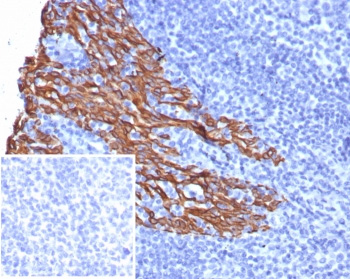- Tel: 858.663.9055
 Email: info@nsjbio.com
Email: info@nsjbio.com
- Tel: 858.663.9055
- Email: info@nsjbio.com
Cytokeratin 5 Antibody reagents target keratin 5 (KRT5), a type II intermediate filament protein expressed in basal epithelial cells of stratified squamous epithelia, including the skin, esophagus, and cervix. KRT5 forms heterodimers with keratin 14, providing structural integrity to basal keratinocytes and supporting tissue resilience.
KRT5 is a defining marker of basal epithelial cells and is essential for epidermal development and wound repair. Pathologically, mutations in KRT5 cause epidermolysis bullosa simplex, a genetic skin disorder characterized by blistering. In oncology, KRT5 is used as a marker for basal-like breast cancers and squamous cell carcinomas. Because of its dual role in physiology and disease, the Cytokeratin 5 Antibody is a valuable reagent in dermatology, oncology, and pathology. The CK5 Antibody further supports broader applications in epithelial biology and translational research.
NSJ Bioreagents provides Cytokeratin 5 Antibodies validated for immunohistochemistry, western blotting, immunofluorescence, ELISA, and flow cytometry. Each Cytokeratin 5 Antibody undergoes rigorous quality control to ensure specificity, sensitivity, and reproducibility.
By selecting Cytokeratin 5 Antibodies from NSJ Bioreagents, researchers gain tools optimized for clarity and consistency. Our antibodies deliver reliable staining in skin, esophagus, and tumor biopsies, reproducible detection in protein lysates, and robust performance across research and clinical applications. Detailed datasheets, recommended controls, and validated protocols further enhance confidence in reproducibility.
The Cytokeratin 5 Antibody supports diverse applications across dermatology, oncology, and diagnostics.
Cytokeratin 5 Antibodies identify basal keratinocytes in stratified squamous epithelia.
The Cytokeratin 5 Antibody clarifies structural roles in epidermal integrity and resilience.
CK5 Antibody reagents support research into keratinocyte biology and wound repair.
Cytokeratin 5 Antibodies detect mutations linked to epidermolysis bullosa simplex.
The Cytokeratin 5 Antibody supports research into genetic skin fragility syndromes.
CK5 Antibody reagents validate biomarkers for inherited keratinopathies.
Cytokeratin 5 Antibodies are key markers in distinguishing basal-like breast cancer.
The Cytokeratin 5 Antibody is applied in immunohistochemistry to classify squamous cell carcinomas.
CK5 Antibody reagents support biomarker-driven oncology trials.
Cytokeratin 5 Antibodies confirm basal cell lineage in biopsies.
The Cytokeratin 5 Antibody supports differential diagnosis of epithelial tumors.
CK5 Antibody tools are used in diagnostic panels alongside CK14 and p63.
Cytokeratin 5 Antibodies track basal keratinocyte specification in embryogenesis.
The Cytokeratin 5 Antibody validates epithelial differentiation in organoid models.
CK5 Antibody reagents support regenerative medicine approaches.
Cytokeratin 5 Antibodies are applied in biomarker validation for oncology.
The Cytokeratin 5 Antibody supports patient monitoring in clinical trials.
CK5 Antibody tools contribute to personalized medicine by stratifying patients based on tumor markers.
KRT5 is a cornerstone biomarker for basal epithelial biology and carcinoma classification. The Cytokeratin 5 Antibody provides precise detection of this protein, while the CK5 Antibody complements its use in translational and diagnostic settings.
In dermatology, Cytokeratin 5 Antibodies reveal basal keratinocyte function and skin disease pathology. In oncology, the Cytokeratin 5 Antibody highlights basal-like phenotypes and assists in tumor subtyping. In pathology, CK5 Antibody reagents improve diagnostic accuracy for epithelial tumors.
Clinically, accurate detection of KRT5 expression is critical for diagnosis, prognosis, and therapy selection. Cytokeratin 5 Antibodies ensure reproducibility and reliability, bridging laboratory science with clinical application.
Cytokeratin 5 is an essential intermediate filament protein with important roles in epithelial stability, skin disease, and cancer. The Cytokeratin 5 Antibody equips researchers and clinicians with validated reagents for detecting KRT5 in dermatology, oncology, and pathology, while the CK5 Antibody provides complementary applications in translational research. By ensuring specificity and reproducibility, these antibodies remain indispensable for advancing epithelial biology and improving clinical outcomes.

IHC staining of FFPE human tonsil tissue with recombinant Cytokeratin 5 antibody (clone rKRT5/6969, cat # V4279). Inset: PBS used in place of primary Ab (secondary Ab negative control).
